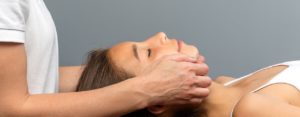Temporomandibular Joint (TMJ) Dysfunction is a common cause of jaw, face, ear, and neck pain. The condition is not life-threatening, but if symptoms persist, they can affect the quality of a person’s life. It can be characterised by a combination of symptoms including:
- Ear, jaw, face, or neck pain
- Headache-usually around the temple area
- Restriction when trying to open your mouth
- Locking of the jaw when opening your mouth to yawn or eat
- Clicking or popping when opening your mouth to yawn or eat
- Ringing in the ears or tinnitus
- Pressure or blocked feeling in the ears
The Anatomy
The Temporomandibular Joints are a pair of joints that allow us to talk, eat and yawn. They are located just in front of your ears and attaches the mandible (lower jaw) to the temporal bone at the side of the skull. The muscles attaching to the joint are responsible for all movements including the opening and closing of the mouth, side to side movements, and the shifting of the mandible backward and forwards.
TMJ pain is most often caused by the displacement of the disc which sits within the joint. Clicking in the joint is caused by the disc moving back into place with every movement. Because of the irregularity within the joint, the muscles attaching to the joint will become tight and irritated causing discomfort under the jaw and/or over the cheek of the same side.
What can trigger TMJ pain?
- Bruxism (teeth grinding)
- Trauma to the jaw
- Arthritis
- Chewing gum excessively
- Stress
- An improper bite or brace wearing
Self-care:
- Avoid eating tough, chewy foods that may aggravate the TMJ, and stick to eat soft foods.
- Massage the painful jaw muscles over the cheek and under the jaw to give temporary relief.
- Try to de-stress and be mindful of stressful triggers in everyday life- for example when sitting in traffic on the way to work be conscious of where you’re holding the tension in your upper body and make sure you’re not clenching your jaw.
- If you have a retainer or nightguard wear it! Not only will it protect your teeth from grinding at night time, but it will also reduce the pressure exerted on the disc within the TMJ. If you suspect your grind your teeth at night time then talk to your dentist and they will make a guard to fit your teeth.

How can Manual Therapy help?
Provided there is no suspicion of an ear or tooth infection your manual therapist can work with you to increase stability within the joint, decrease pain, and to improve range of movement.
After examination of the TMJ, neck, and surrounding muscles, your therapist will work with the following aims in mind:
- To release any muscle tension/ trigger points within the TMJ muscles.
- To engage and strengthen the muscles attaching to the TMJ to provide joint stability and rebalance how the two joints work together.
- To improve the functioning of the upper neck which acts as a pivot for the TMJ to open around.
- To rebalance the movement through the cranial bones, including the temporal (temple bone), which may be restricted due to surrounding muscular tension.
